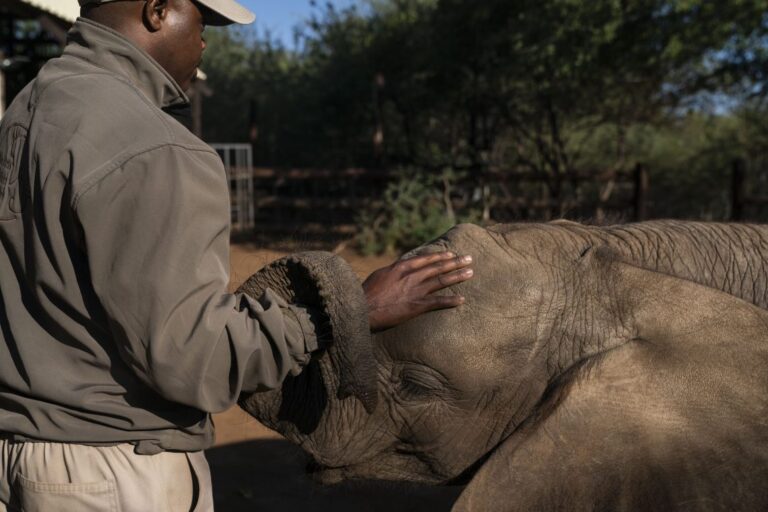Innovative models of wildlife tourism have the potential to boost both conservation and economic development across Africa.
 The elephant orphanage in Kasane, Botswana, home to around 130,000 elephants, about one-third of the total population of Africa. © Getty Images ×
The elephant orphanage in Kasane, Botswana, home to around 130,000 elephants, about one-third of the total population of Africa. © Getty Images ×
In a nutshell
Tourism is key to Africa’s growth prospects. As the continent urbanizes, wildlife tourism faces challenges. Emerging business models can boost broader prosperity.
Africa has the world’s fastest growing population of any continent, but many countries suffer from persistent poverty and hunger, as well as slowing economic growth. Africa’s population is growing at 2.5% per year and is expected to grow by 740 million people by 2050, but more than a third of its people currently earn less than $2.15 a day.
Too many people suffer from poverty and unemployment, and the outlook is bleak. Projections suggest that a rapidly growing labor force will compete for just 3 million new full-time wage jobs created each year. Projected economic growth of 2.5 percent is a disappointing prospect for the 12 million young people who enter the labor market each year. To make matters worse, 226 million people currently suffer from hunger.
The travel and tourism sector is one of the few bright spots, expected to create 1.8 million new jobs in 2023 and boost the continent’s gross domestic product (GDP) by $168 billion over the next decade. About 25 million Africans are already employed in tourism, which accounted for 5.6 percent of the continent’s total employment last year.
Wildlife tourism is a mainstay of tourism in Africa, generating $12 billion in annual revenue in countries such as Kenya, Tanzania and Botswana. As the continent urbanizes, the big question is whether this industry can continue to thrive. By 2033, more than half of Africa’s population is expected to live in cities. Rapid urbanization will put ever-greater pressure on Africa’s unique ecosystems.
The survival of wildlife tourism depends on the conservation of rural areas currently under threat from development, agriculture and wildlife poaching. But so far, local communities have not benefited enough from conservation or tourism, and we have not been able to provide enough incentives to protect the land and the wildlife that lives there.
An outdated approach to conservation
The colonialist “fortress conservation” approach (creating isolated areas to protect ecosystems from human interference) meant that local people were forced out of protected areas, which then became state managed. The government eventually allowed the development of tourist access through state services, or private safari lodge operators and professional hunters. Because local people derived little or no benefit from these protected areas, they had little incentive to protect or meaningfully participate in the wildlife tourism economy.
Forbidden practices such as traditional subsistence hunting and wild fruit gathering contributed to marginalization from wildlife tourism and made it easier for criminal gangs to poach high-value species. For example, 406 rhinos were poached from state land and 93 from private reserves in South Africa last year. The United Nations Office on Drugs and Crime released the World Wildlife Report in 2020, covering the poaching and trafficking of everything from elephants to pangolins, highlighting the scope and nature of these crimes. Wildlife crime is global, as evidenced by the approximately 180,000 seizures in 149 countries between 1999 and 2018, including nearly 6,000 species. Corruption is facilitating the depletion of Africa’s natural flora and fauna resources through transnational crime. Criminals are stealing the future of Africa’s wildlife tourism industry. Their beneficiaries often include extremist terrorist groups.
Read more articles by François Baird
Partnership Model
Protecting Africa’s wildlife reserves is essential for stability and growth, but the current fortress protection system is outdated. In Botswana, for example, a herd of 130,000 elephants was so large and had such a devastating impact on plants and people that President Mokgwetsi Masisi threatened to send 20,000 elephants to Germany after the German Green Party opposed allowing elephant trophies into the country.
Now, Botswana is investing in the success of wildlife conservation and tourism, seeking to involve local people in concession deals for lucrative luxury safari lodges, in the hope that it will create incentives for locals to become more involved in the industry and protect protected areas. This approach runs the risk of being concession-driven: well-connected individuals could claim the requisite 30 percent “local” concession, leaving communities actually close to these places marginalized.
But models of how it can be done well are already showing signs of success. In one notable case study, the Kumaga community along the Boteti River is demonstrating a different approach by working with Moera Lodge Safaris as co-owners of a lodge and tourism business. The lodge was built by community members, primarily using local materials, in a location where thousands of zebras and wildebeest congregate in the valley below the riverbank during one of Africa’s last great migrations.
×
Facts and figures
International tourist arrivals, selected countries

A joint effort between Botswana and foreign investors, experienced lodge operators, and the Kumaga people (who own the land rights) established a luxury safari and lodge operation. The people’s share in the enterprise is held in trust, and local people are employed in construction and staff, as well as building the village’s community arts centre. The reserve was converted from agriculture to wildlife conservation in the early 1980s by Kumaga chief Ngande; his grandson, the current chief, believes the lodge will position the village as a tourism hub for the Kalahari and create more jobs for the community.
The investors involved (including Prince Harry, Duke of Sussex) hope that this project and similar ones will serve as a blueprint for future wildlife tourism in Botswana, and perhaps the entire African continent. Other sites with model operations include Setali Camp in the Okavango Delta in Botswana, and the Northern Wildlife Trust and Borana Conservancy in Kenya. It is notable that the South African Department of Forestry, Fisheries and Environment recently announced a new proposal to establish seven integrated “megalandscapes” to monetize consumptive wildlife use with the aim of expanding local and international wildlife hunting markets, including fair-track trophy hunting within the country. Captive breeding of lions and rhinos for hunting purposes, so-called “canned hunting”, is being phased out.
×
scenario
More likely: a new model emerges
Perhaps a new Botswana government policy requiring at least 30 percent local ownership of safari lodge concessions will spur local interest. Models like Kumaga could be commercially and developmentally successful, stimulating tourism opportunities. Such success could spur other lodges on tribal lands to adopt similar arrangements and encourage other tribal communities to follow suit.
This initiative has already spread to Botswana’s neighbours, Namibia, Zambia and South Africa. Many countries in East Africa are moving in a similar direction, but Central and West Africa are far behind. East and South Africa have the potential to become Africa’s conservation epicentre through wildlife tourism partnerships between commercial operators and local communities. This will enable wildlife tourism, including for consumption purposes, to become an economic growth engine for rural areas in these regions.
Unlikely: Exacerbation of existing problems
South Africa’s “empowerment” policies, which require black shareholders to own a certain percentage of companies, are often controversial and have often failed to deliver broader benefits to historically disadvantaged communities. Corruption also plays a role in preventing investment partnerships, while crime and government incompetence (such as South Africa’s tourist visa problem) also hinder tourism.
If these problems become widespread and worsen across Botswana and Southern Africa, they will stunt the expansion of wildlife tourism assets that are jointly owned by local communities and commercial operators. Although unlikely in Botswana given past performance, such a scenario would prevent wildlife tourism from driving rural economic growth and development in the region and across Africa.
For industry-specific scenarios and customized geopolitical intelligence, please contact us and we will provide you with more information on our advisory services.

Sign up for our newsletter
Get expert insights delivered to your inbox every week.

